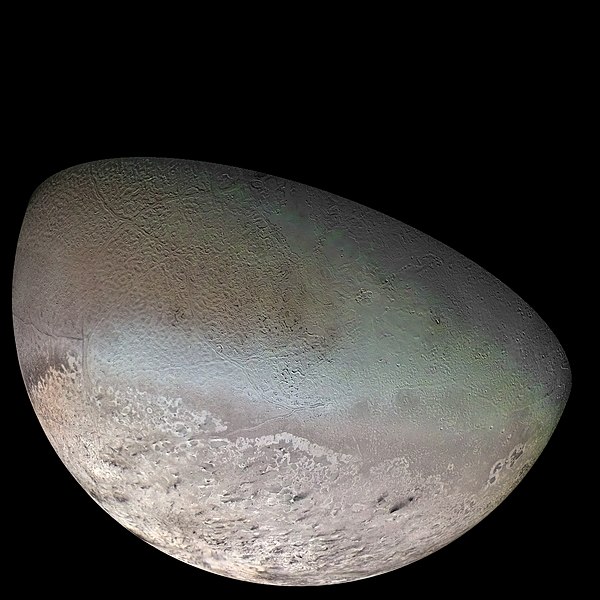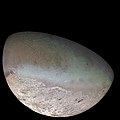Dosya:Triton moon mosaic Voyager 2 (large).jpg
bilgipedi.com.tr sitesinden

Bu önizlemenin boyutu: 600 × 600 piksel. Diğer çözünürlükler: 240 × 240 piksel | 480 × 480 piksel | 768 × 768 piksel | 1.024 × 1.024 piksel | 2.048 × 2.048 piksel | 4.700 × 4.700 piksel.
Orijinal dosya (4.700 × 4.700 piksel, dosya boyutu: 12,11 MB, MIME türü: image/jpeg)
Bu dosya Wikimedia Commons deposunda bulunmaktadır ve diğer projeler tarafından kullanılıyor olabilir. Aşağıda dosya açıklama sayfasındaki açıklama gösteriliyor.
Özet
| AçıklamaTriton moon mosaic Voyager 2 (large).jpg |
English: Global Color Mosaic of Triton, taken by Voyager 2 in 1989
Deutsch: Globales Farbmosaik von Triton, 1989 aufgenommen durch Voyager 2 |
| Tarih | |
| Kaynak | http://photojournal.jpl.nasa.gov/catalog/PIA00317 |
| Yazar | NASA / Jet Propulsion Lab / U.S. Geological Survey |
English: original NASA caption: Global color mosaic of Triton, taken in 1989 by Voyager 2 during its flyby of the Neptune system. Color was synthesized by combining high-resolution images taken through orange, violet, and ultraviolet filters; these images were displayed as red, green, and blue images and combined to create this color version. With a radius of 1,350 km (839 mi), about 22% smaller than Earth's moon, Triton is by far the largest satellite of Neptune. It is one of only three objects in the Solar System known to have a nitrogen-dominated atmosphere (the others are Earth and Saturn's giant moon, Titan). Triton has the coldest surface known anywhere in the Solar System (38 K, about -391 degrees Fahrenheit); it is so cold that most of Triton's nitrogen is condensed as frost, making it the only satellite in the Solar System known to have a surface made mainly of nitrogen ice. The pinkish deposits constitute a vast south polar cap believed to contain methane ice, which would have reacted under sunlight to form pink or red compounds. The dark streaks overlying these pink ices are believed to be an icy and perhaps carbonaceous dust deposited from huge geyser-like plumes, some of which were found to be active during the Voyager 2 flyby. The bluish-green band visible in this image extends all the way around Triton near the equator; it may consist of relatively fresh nitrogen frost deposits. The greenish areas includes what is called the cantaloupe terrain, whose origin is unknown, and a set of "cryovolcanic" landscapes apparently produced by icy-cold liquids (now frozen) erupted from Triton's interior.
Deutsch: Ursprüngliche Überschrift der NASA: Globales Farbmosaik von Triton, das 1989 während des Vorbeiflugs am Neptun abgelichtet wurde. Die Farbe wurde durch Kombination von hochauflösenden Bildern, die durch orange, rote, violette und ultraviolette Filter aufgenommen wurden, zusammengesetzt; diese wurden in rote, grüne und blaue Bilder umgewandelt und dann zusammengefasst, um ein Farbbild zu generieren. Mit einem Radius von 1350 km, etwa 22 % kleiner als der Erdmond, ist Triton der mit Abstand größte Mond Neptuns. Er ist einer von nur drei Objekten im Sonnensystem, die eine stickstoffdominierte Atmosphäre aufweisen. (Die anderen zwei sind die Erde und der große Saturnmond Titan.) Triton hat mit 38 K (−235 °C) die kälteste bekannte Oberfläche im ganzen Sonnensystem. Er ist so kalt, dass der Großteil des Stickstoffs als Frost kondensiert ist. Das macht ihm zum einzigen Satelliten im Sonnensystem, von dem man weiß, dass seine Oberfläche hauptsächlich aus Stickstoffeis besteht. Die rosafarbenen Ablagerungen bilden eine massive Südpolkappe. Diese besteht wahrscheinlich aus Methaneis, das unter Sonnenlicht zu roten und rosa Verbindungen reagiert hat. Die dunklen Streifen, die das rötliche Eis überlagern, könnten eis- und vielleicht kohlehaltiger Staub sein, der von riesigen geysirartigen Rauchfahnen abgelagert wurde. Von diesen Geysiren wurden einige aktive durch Voyager 2 beobachtet. Das blaugrüne Band, das im Bild sichtbar ist, erstreckt sich entlang des ganzen Äquators. Es könnte aus relativ frisch gefrorenen Stickstoffablagerungen bestehen. Die grünlichen Gebiete beinhalten das sogenannte „Cantaloupe-Terrain“ (benannt nach der Melonenart), dessen Ursprung unbekannt ist, und eine Reihe von „kryovulkanischen“ (eisvulkanischen) Landschaften, die anscheinend von eisig kalten, nun gefrorenen Flüssigkeiten stammen, die aus Tritons Innerem ausgebrochen sind.
Lisanslama
| Public domainPublic domainfalsefalse |
| Bu dosya NASA tarafından üretildiği için kamu malıdır. Aksi belirtilmediği sürece "NASA tarafından üretilen malzemenin telif hakkı olmadığı" NASA telif politikasında belirtilmiştir. (Bkz. Template:PD-USGov, NASA copyright policy page veya JPL Image Use Policy.) |  | |
 |
Uyarılar:
|
Altyazılar
Bu dosyanın temsil ettiği şeyin tek satırlık açıklamasını ekleyin.
Triton portrayed by Voyager 2 in 1989
Triton, Voyager 2:en kuvaamana vuonna 1989
Globales Farbmosaik von Triton, 1989 aufgenommen durch Voyager 2
Bu dosyada gösterilen öğeler
betimlenen
25 Ağustos 1989
image/jpeg
Dosya geçmişi
Dosyanın herhangi bir zamandaki hâli için ilgili tarih/saat kısmına tıklayın.
| Tarih/Saat | Küçük resim | Boyutlar | Kullanıcı | Yorum | |
|---|---|---|---|---|---|
| güncel | 20.40, 10 Ekim 2011 |  | 4.700 × 4.700 (12,11 MB) | wikimediacommons>Jbarta | Minimally compressed JPG from TIFF original at NASA. This image has already been colored by NASA. I think we have no business trying to "fix" the coloring. The only alteration made from the NASA original is to enlarge the canvas to enclose the complete sp |
Dosya kullanımı
Aşağıdaki sayfa bu dosyayı kullanmaktadır:
Meta veri
Bu dosyada, muhtemelen fotoğraf makinesi ya da tarayıcı tarafından eklenmiş ek bilgiler mevcuttur. Eğer dosyada sonradan değişiklik yapıldıysa, bazı bilgiler yeni değişikliğe göre eski kalmış olabilir.
| JPEG dosyası yorumu | Minimally compressed jpg from tiif original at http://photojournal.jpl.nasa.gov/catalog/PIA00317 |
|---|
"http://bilgipedi.com.tr/wiki/Dosya:Triton_moon_mosaic_Voyager_2_(large).jpg" sayfasından alınmıştır